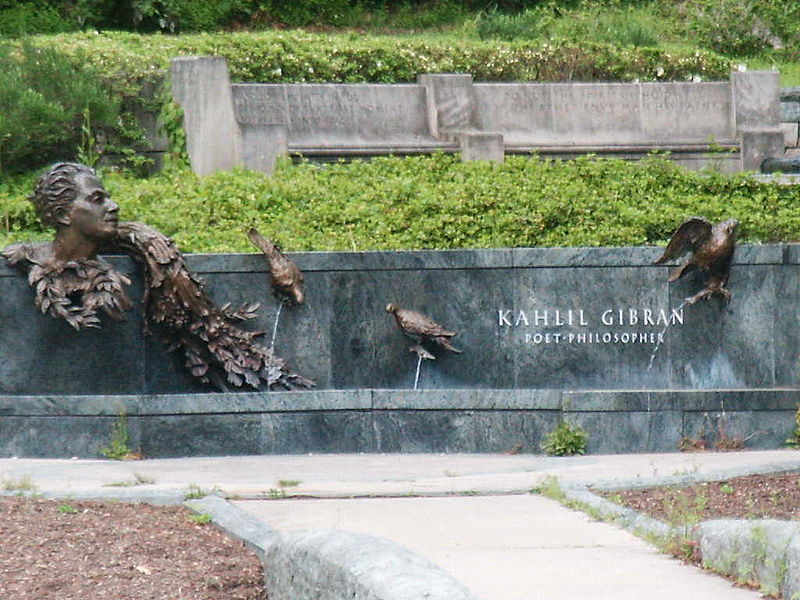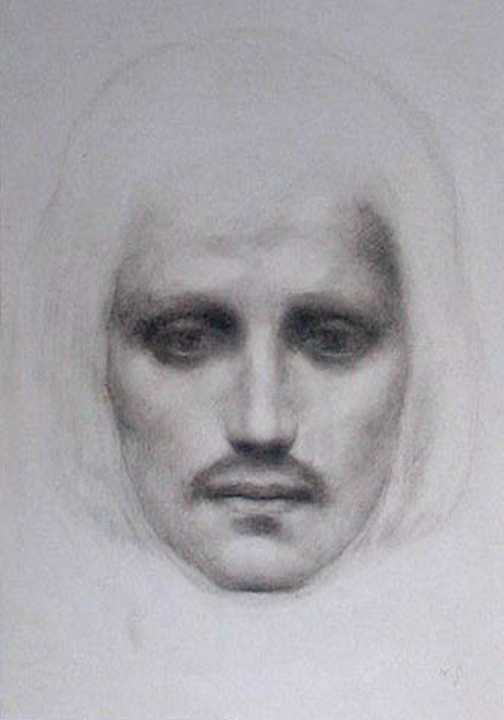THE PROPHET
BY
Kahlil Gibran
Khalil Gibran (also known as Kahlil Gibran; born Gibran Khalil Gibran, Arabic: ????? ???? ?????, Syriac: ????? ???? ?????) (born January 6, 1883; died April 10, 1931) was a Lebanese American artist, poet and writer. He was born in today's Lebanon and spent much of his productive life in the United States.
Birth and Childhood in Lebanon (1883-1895)
Immigration to the U.S. (1885-1898)
Education in Lebanon (1898-1902)
Death in the Family and Return to the U.S. (1902-1908 )
Traveling to Paris and the Move to New York (1908-1914)
The War Years and the Publication of The Prophet (1914-1923)
Death and the Homecoming (1923-1931)
Youth in Lebanon
According to a relative of the same name, the Gibran family's origins are obscure. Though his mother was the "offspring of a priestly, and important family", the Gibran clan was "small and undistinguished." He was born in the Christian Maronite town of Bsharri in today's northern Lebanon - at the time, part of the Ottoman Empire - and grew up in the region of Bsharri. His maternal grandfather was a Maronite Catholic priest.
As a result of his family's poverty, Gibran did not receive any formal schooling during his youth in Lebanon. However, priests visited him regularly and taught him about the Bible, as well as the Syriac and Arabic languages. During these early days, Gibran began developing ideas that would later form some of his major works. In particular, he conceived of The Prophet at this time.
After Gibran's father went to prison for fraud and tax evasion, Ottoman authorities confiscated his family's property. Authorities released Gibran's father in 1894, but the family had by then lost their home. Gibran's mother, Kamilah, decided to follow Gibran's uncle and emigrate to the United States. Gibran's father chose to remain in Lebanon. Gibran's mother, along with Khalil, his younger sisters Mariana and Sultana, and his half-brother Peter (a.k.a. Butros) left for New York on June 25, 1895.
Youth in America

Size of this preview: 497 × 599 pixels
[Kahlil Gibran in Middle Eastern(?) costume with leopard skin and staff, seated]
At the time the second largest Lebanese-American community was in Boston's South End, so the Gibrans decided to settle there. His mother began working as a peddler to bring in money for the family, and Gibran started school on September 30, 1895. Since he had had no formal schooling in Lebanon, school officials placed him in a special class for immigrants to learn English. Gibran's English teacher suggested that he Anglicise the spelling of his name in order to make it more acceptable to American society. Kahlil Gibran was the result.
In his early teens, the artistry of Gibran's drawings caught the eye of his teachers and he was introduced to the avant-garde Boston artist, photographer, and publisher Fred Holland Day, who encouraged and supported Gibran in his creative endeavors.
Art and poetry
A publisher used some of Gibran's drawings for book covers in 1898, and Gibran held his first art exhibition in 1904 in Boston. During this exhibition, Gibran met Mary Elizabeth Haskell, a respected headmistress ten years his senior. The two formed an important friendship that lasted the rest of Gibran's life. Though publicly discreet, their correspondence reveals an exalted intimacy. Haskell influenced not only Gibran's personal life, but also his career. In 1908, Gibran went to study art with Auguste Rodin in Paris for two years. This is where he met his art study partner and lifelong friend Youssef Howayek. He later studied art in Boston.
While most of Gibran's early writings were in Syriac and Arabic, most of his work published after 1918 was in English. Gibran also took part in the New York Pen League, also known as the "immigrant poets", alongside other important Lebanese American authors such as Ameen Rihani ("the father of Lebanese American literature"), Mikhael Naimy and Elia Abu Madi.
Much of Gibran's writings deal with Christianity, mostly condemning the corrupt practices of the Eastern churches and their clergies during that era. His poetry is notable for its use of formal language, as well as insights on topics of life using spiritual terms.
Gibran's best-known work is The Prophet (book), a book composed of 26 poetic essays. During the 1960s, The Prophet became especially popular with the American counterculture and New Age movements. The Prophet (book) remains famous to this day, having been translated into more than 20 languages.
One of his most notable lines of poetry in the English speaking world is from 'Sand and Foam' (1926), which reads : 'Half of what I say is meaningless, but I say it so that the other half may reach you'. This was taken by John Lennon and placed, though in a slightly altered form, into the song Julia from The Beatles' 1968 album The Beatles (a.k.a. The White Album).Gibran also inspired John F. Kennedy's often quoted 1961 inaugural address with his 1925 article, "The New Frontier," which contained the epigramattic : "Are you a politician asking what your country can do for you or a zealous one asking what you can do for your country? If you are the first, then you are a parasite; if the second, then you are an oasis in a desert."[citation needed]
Juliet Thompson, one of Khalil Gibran's acquaintances, said that Gibran told her that he thought of `Abdu'l-Bah?, the divine leader of the Bah?'? Faith in his lifetime, all the way through writing The Prophet (book). `Abdu'l-Bah?'s personage also influenced Jesus, The Son of Man, another book by Gibran. It is certain that Gibran did two portraits of him during this period
Death and legacy

Size of this preview: 800 × 600 pixels
This photograph (1 of 2) depicts the Khalil Gibran Memorial,
located along the 3100 block of Massachusetts Ave. NW in Washington, D.C.
Gibran died in New York City on April 10, 1931: the cause was determined to be cirrhosis of the liver and tuberculosis. Before his death, Gibran expressed the wish that he be buried in Lebanon. This wish was fulfilled in 1932, when Mary Haskell and his sister Mariana purchased the Mar Sarkis Monastery in Lebanon. Gibran remains the most popular Lebanese-American writer ever.
Gibran willed the contents of his studio to Mary Haskell. There she discovered her letters to him spanning 23 years. She initially agreed to burn them because of their intimacy, but recognizing their historical value she saved them. She gave them, along with his letters to her which she had also saved, to the University of North Carolina Library before she died in 1964. Excerpts of the over six hundred letters were published in "Beloved Prophet" in 1972.
Selected works
Size of this preview: 800 × 600 pixels
A picture of the Gibran Museum, located in Bsharri, Lebanon.
In Arabic:
- Ara'is al-Muruj (Nymphs of the Valley, also translated as Spirit Brides, 1906)
- al-Arwah al-Mutamarrida (Spirits Rebellious, 1908)
- al-Ajniha al-Mutakassira (Broken Wings, 1912)
- Dam'a wa Ibtisama (A Tear and A Smile, 1914)
- The Madman (1918)
- al-Mawakib (The Processions, 1919)
- al-‘Aw?sif (The Tempests, 1920)
- The Forerunner (1920)
- al-Bada'i' waal-Tara'if (The New and the Marvellous,1923)
In English:
- The Prophet, (1923)
- Sand and Foam (1926)
- The Son of Man (1928)
- The Earth Gods (1929)
- The Wanderer (1932)
- The Garden of The Prophet (1933)
- Beloved Prophet, The love letters of Kahlil Gibran and Mary Haskell, and her private journal (1972, edited by Virginia Hilu)
http://en.wikipedia.org/wiki/Image:Khali_Gibran.jpg
'Spirit > e—The Prophet' 카테고리의 다른 글
| THE PROPHET - On Giving - Kahlil Gibran (0) | 2007.07.24 |
|---|---|
| THE PROPHET - On Children - Kahlil Gibran (0) | 2007.07.23 |
| THE PROPHET - On Marriage - Kahlil Gibran (0) | 2007.07.18 |
| THE PROPHET - On Love - Kahlil Gibran (0) | 2007.06.12 |
| THE PROPHET - The Coming Of The Ship - Kahlil Gibran (0) | 2007.06.12 |






